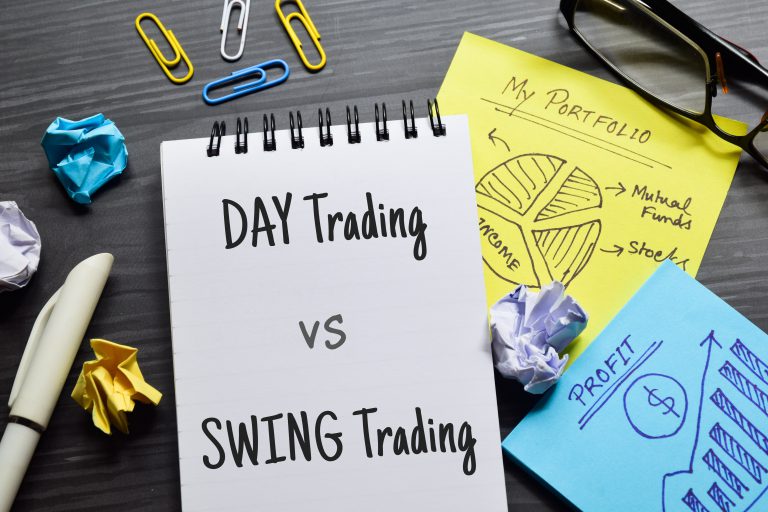Enjoy this post? Share the love.
Developing a winning trading system begins with choosing the trading style that’s right for you.
But especially when you are first learning how to trade, choosing the trading style that’s right for you can be a bit daunting.
There’s day trading, swing trading, position trading, momentum trading, and more.
Some trading styles involve buying and selling multiple times in the same day. This is known as “day trading” (also called “intraday trading”).
Other methods are still short-term, but with longer holding periods, such as a few days to weeks. This type of trading style is known as “swing trading.”
Continue reading, as we walk through the benefits of swing trading vs day trading to help you decide the best trading style for YOU.
What is Swing Trading vs Day Trading?
If you tell a stranger that you are a stock trader, they may automatically assume you’re a day trader.
After all, day trading has gotten much exposure and publicity (not always positive) over the years.
Still, many professional stock and crypto traders prefer a swing trading style instead.
Below is a simple comparison of day trading vs swing trading, including the top pros and cons of both.
What is Day Trading?
Day trading is a strategy that involves buying and selling stocks or crypto within the same day.
Average holding time varies greatly, from just seconds to a full day.
Scalpers may even hold a stock or crypto for only a few seconds, focusing on a rapid number of trades with small profits in a single day. However, most day traders hold stocks for several hours within the trading day.
Day traders take advantage of intraday price and volume momentum to open and close trades in the same day. Day traders may even open and close multiple positions at the same time.
Day traders constantly scan the market looking for valid trade setups and reliable chart patterns. Their basic objective is to buy a stock or crypto moving on high momentum, then to sell it at a higher price by the end of day. If successful, the day trader scores a gain equal to the difference between the purchase and sale price.
Proper day trading is like a full-time job, as it requires constantly monitoring the market throughout the day.
What are the Pros and Cons of Day Trading?
PROS:
✔ Day trading lowers risk exposure of after-hours market news that can lead to opening gap downs.
✔ Like swing trading, proper swing trading uses a technical, rule-based trading strategy.
✔ Because day traders typically make several trades per day, it’s possible to make a large amount of profit in a short amount of time (note this work both ways if you don’t cut losses).
✔ Day traders are their own bosses. Unlike a 9-5 job, day traders have the freedom to work whenever they want, and make as many trades as they are comfortable with.
CONS:
⚠ Requires highly active trade management and sitting in front of a computer all day.
⚠ Quite time consuming. May only be suitable for full-time traders.
⚠ Day trading is physically and mentally demanding (requires quick reflexes).
result in a loss of money.
⚠ Day trading requires a significant amount of capital. In the USA, day trading stocks legally requires a minimum account balance of $25,000. If you don’t have enough money saved up to make multiple trades per day, you can’t day trade stocks (note that crypto trading does not have the same requirement).
⚠ Day trading often entails a higher risk, in anticipation for a potential higher reward.
⚠ Impulsivity is common. Because day trading is such a high-pressure activity, it’s easy to succumb to impulsive behavior and buy or sell stock too quickly. This can lead to bad trades, which will ultimately

What is Swing Trading?
Swing trading in stocks involves buying and selling stocks over a period of days to weeks.
Essentially, swing traders take advantage of “swings” in the market’s momentum.
For example, many swing trading strategies use a simple method of buying uptrending stocks on a pullback, then selling into strength of a short-term rally.
The basic idea is to identify stocks that are trending in one direction and find a price to enter where you’ll see the most profit potential. You then set a price at which you’ll exit the trade and realize your gains.
For example, let’s say you buy HappyTimes stock after it gaps up from a blowout earnings announcement.
You continue holding the stock while bullish momentum carries it higher over the next several weeks.
You set a price at which you’ll sell the stock when the momentum starts to slow down.
Eventually, the buyers take a rest and the price starts to pull back from the high. You now exit the stock with a substantial profit and move on to the next swing trade setup.
Overall, swing trading is a flexible, well-balanced trading style with solid reward-risk characteristics.
What are the Pros and Cons of Swing Trading?
PROS:
✔ More relaxed approach – Since swing trading means that you’re holding stocks for a longer period of time, you don’t have to be as stressed out or anxious. You don’t have to check your stocks every hour (or even every day) like day traders do.
✔ Perfect side hustle – Set buy and sell orders outside of market hours. Work around your day job.
✔ Longer holding periods give you more control. Swing trading means that you’ll buy stocks, hold them for a few days to weeks (sometimes longer), and then sell them.
✔ More time to research the stock – One of the biggest benefits of swing trading is that you have more time to do research on a company before deciding to invest.
✔ Flexible enough to take advantage of shorter-term technical trends in both directions
✔ Strong risk control to keep losses in check, especially when combined with a market timing system..
CONS:
⚠ Can require a bit of patience at times, such as when market is just drifting sideways for a while.
⚠ Less “exciting” than day trading—but do you really want that? Go to Vegas if you are trading for the “excitement.”
Swing vs Day Trading: Which is Better?
Now that you understand the benefits of swing trading vs day trading, you may have an opinion on which trading style is best.
But when comparing swing trading vs day trading styles, there simply is no “right” answer to that question.
Rather, the best trading style is a personal decision that should be based on your own risk tolerance and patience levels.
If you dread the thought of sitting in front of your computer all day, staring at flashing symbols, then you swing trading may be a better fit for you than day trading.
On the other hand, if you prefer the fast-paced action of placing multiple trades per day (and carefully managing them), then day trading may be suitable for you. Just make sure you’re disciplined and follow strict money management rules.
I personally started out as a day trader 25 years ago, but eventually found it to be too mentally and physically demanding. That’s when I started focusing on swing trading stocks and developing the Morpheus Trading system.
Conclusion
By now, you should be clear on the most important differences between swing trading vs day trading.
Both short-term trading strategies come with their own pros and cons, as listed above.
Day trading is generally considered to be a “high risk, high reward” trading style that requires a significant amount of capital and continuous attention to the market.
Swing trading is less risky, more relaxed, and more suitable for investors who want to make a steady, longer-term profit.
In our exclusive Wagner Daily report, most of our stock trades are held from several weeks to months (depending on market conditions).
The Morpheus Trading system is designed to be completely end-of-day, giving you the perfect side hustle as a swing trader.
Regardless of which trading strategy you choose, it’s important to make sure that you’re well-informed so that you can make smart decisions.
When comparing swing trading vs day trading, both methods can be consistently profitable methods of investing—as long as you maintain discipline and control your trading psychology.

Is swing trading safer than day trading?
Comparing swing to day trading, both styles can be equally “safe” if proper discipline and risk management rules are in place.
Swing trading may be perceived as “safer” because it is slower paced than day trading.
How much do swing traders make a day?
The profit potential of a swing trader largely depends on the size of the trading account—the larger the account, the more possible gains.
Broad market trend, personal discipline, and validity of the trading strategy also play a big role in how much swing traders make per day.
What Are the “Swings” in Swing Trading?
“Swings” are the short-term price movements that swing traders seek to capture when momentum shifts within an uptrend.
For example, if you buy a pullback in an uptrending stock, then sell into strength of the next wave up a few days later—before the swing back down.
Which provides a more reliable return, swing trading or day trading?
In a steadily trending market, a swing trading strategy based on trend trading may generate more consistent and reliable returns than day trading.
However, a solid day trading strategy may outperform swing trading returns in a choppy or range-bound market.
What time frames should you use for swing trading?
Short-term swing traders typically hold their stocks and crypto trades from several days to weeks.
Intermediate-term swing traders (also known as position traders) may hold stocks for up to 3 to 6 months.
Ready to start learning how to swing trade—the right way?
We have helped more than 70,000 swing traders since 2002. Get started now to receive Swing Trade Alerts and access to our professionally moderated Swing Trader Chatroom—where we teach our proven swing trading strategy to members every day.
Here’s what long-time member Catherine O. has to say:
“I am very much enjoying using the Swing Trader Chatroom. The input and feedback from the Morpheus team is invaluable. Having others to interact with who are all wanting to improve their trading skills is very motivating.”
Learn more about how to become a successful Morpheus swing trader, regardless of your experience level.
Enjoy this post? Share the love.




